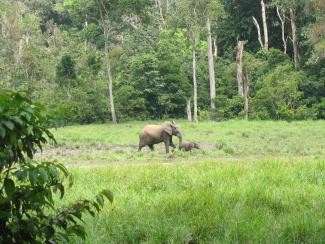The Central African rainforest is home to some of the world’s most spectacular wildlife, including gorillas, chimpanzees and forest elephants. The planet’s second largest tropical rainforest ecosystem, second only to the Amazon, it also plays an important role in slowing down global climate change because the forest absorbs greenhouses gases, which keeps them from being released into the atmosphere. Almost 80 million people depend on the forest for their livelihoods from farming, hunting and harvesting of wild fruits and vegetables, edible oils, timber and other essential products.
We help maintain the ecological integrity of the Congo Basin’s tropical rainforest, which is still largely intact while other tropical forests around the world are being severely depleted. USAID’s Central Africa Regional Program for the Environment protects biodiversity, landscapes and livelihoods in seven Central African countries of Central Africa. For example, USAID helps governments and communities plan how the forests and land will be used so that they are conserved for future generations, while at the same time providing products such as medicines, wildlife, wood and other products that can improve living standards today. These plans have put forest management in the hands of local communities—which has been shown to be among the most effective ways to slow deforestation.
USAID’s satellite remote sensing technology helps communities, governments and scientists to better understand the changes caused by human activities and can determine areas where more protection is needed. This technology, along with forest patrols, has enabled governments in the region to better enforce industrial logging regulations.

USAID
